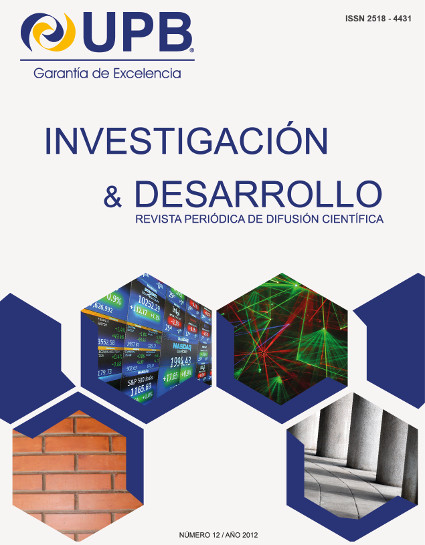FORMACIÓN DE GRÁNULOS ANAEROBIOS SIN LODOS INOCULADOS EN UN REACTOR DE BIOPELÍCULA ANAEROBIA TIPO INTERCAMBIADOR DE CALOR (RBAIC)
Palabras clave:
Reactor de Biopelícula Anaerobia, Granulación, Tratamiento de Aguas Residuales de MelazasResumen
Se ha estudiado experimentalmente el fenómeno de la formación de gránulos anaerobios en la puesta en marcha de un Reactor de Biopelícula Anaerobia Tipo Intercambiador de Calor (RBAIC), utilizado en el tratamiento de aguas residuales provenientes de una planta de procesamiento de melazas de baja concentración, 0,45 g-C L-1. El reactor fue operado en modo de flujo ascendente de un solo paso a bajas temperaturas promedio del líquido (15° C a 25° C) y tiempos de retención hidráulica (TRH) de 16 h y 6,1 h. La granulación puede proceder sin la inoculación de grandes cantidades iniciales de lodo biológico anaerobio. La granulación es posible aún con concentraciones iniciales muy pequeñas de microorganismos, siempre y cuando los mismos estén bien aclimatados al tipo de agua residual y las condiciones ambientales. Es posible tratar tasas de carga orgánica volumétrica entre 1,8 y 3,3 g-DQO L-1 d-1 a temperaturas promedio menores a 25° C con concentraciones de biomasa tan pequeñas como 2 g-SSV L-1. En un RBAIC, se pueden formar gránulos de 0,5 – 2 mm de diámetro en tres meses a temperaturas promedio menores a 25° C.Descargas
Referencias
C. R. Escalera and S. Uchida. “The performance of a heat exchanger-type anaerobic biofilm reactor,” in Water Science & Technology, vol. 24, no. 5, 1991, pp. 149-161.
I. J. Callander and J. P. Barford. “Recent advances in anaerobic digestion technology,” in Process Biochemistry, vol. 18, 1983, p. 24
J. C. Young and P. L. McCarty. “The anaerobic filter for wastewater treatment,” in Proceedings of Purdue Industrial Waste Conference, vol. 22, 1967, p. 559.
G. Lettinga et al. “Use of the upflow sludge blanket (USB) reactor concept for biological wastewater treatment, especially for anaerobic treatment,” in Biotechnology and Bioengineering, vol.22, 1980, p. 699.
H. Harada. “Trends and problems of wastewater treatment technology based on self-immobilization processes.” Journal of Water and Waste, vol. 31, no. 1, 1989, p. 12. (En japonés)
Y. Sakakibara et al. “Analysis of acetate removal rates in methanogen attached biofilm reactors.” Doboku Gakkai Ronbunshi, vol.375 (II-6), 1986, pp. 311-318. (En japonés)
R. E. Speece. “Anaerobic biotechnology for industrial wastewater treatment.” Environmental Science and Technology, vol. 17, 1983, p. 416A.
M. Okada and T. Okubo. “Effect of substrate on the purification characteristics of self-immobilization processes.” Journal of Water and Waste, vol.31, no.1, 1989, p. 12. (En japonés)
J. Dolfing et al. “Chemical and bacteriological composition of granular methanogenic sludge.” Canadian Journal of Microbiology, vol. 31, 1985, pp.744-750. En J. E. Schmidt and B. K. Ahring. Review: Granular sludge formation in upflow anaerobic sludge blanket (UASB) reactors. Biotechnology and Bioengineering, vol. 49, 1996, pp. 229-246.
B.T. Dudley et al. “Image analysis to quantify and measure UASB digester granules.” Biomass Bioenergy, vol. 42, 1993, pp.279 – 283.En J. E. Schmidt and B. K. Ahring. Review: Granular sludge formation in upflow anaerobic sludge blanket (UASB) reactors. Biotechnology and Bioengineering, vol. 49, 1996, pp. 229-246.
S. R. Guiot et al. “Extracellular polymeric substances in anaerobic granules,” in Sixth international Symposium on Anaerobic Digestion (Poster papers. IAWPRC Sao Paulo, Brazil, 1991), p.12. En J. E. Schmidt and B. K. Ahring. Review: Granular sludge formation in upflow anaerobic sludge blanket (UASB) reactors. Biotechnology and Bioengineering, vol. 49, 1996, pp. 229-246.
Descargas
Publicado
Número
Sección
Licencia
Reconocimiento-NoComercial-CompartirIgual
CC BY-NC-SA
Esta licencia permite a otros entremezclar, ajustar y construir a partir de su obra con fines no comerciales, siempre y cuando le reconozcan la autoría y sus nuevas creaciones estén bajo una licencia con los mismos términos.
Los autores pueden realizar acuerdos contractuales adicionales separados para la distribución no exclusiva de la versión publicada del artículo publicado en la revista (por ejemplo, publicarlo en un repositorio institucional o en un libro), sujeto a un reconocimiento de su publicación inicial en esta revista
